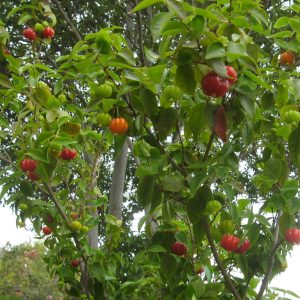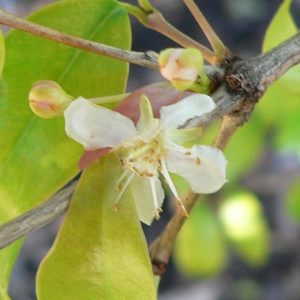Eugenia uniflora
Pitanga, Surinam cherry, Brazilian cherry
Origin
The pitanga is a native of Southern Brazil.
Climate
Pitanga grows well in tropical and subtropical areas. It can grow in cool climates and tolerate some frost, but may not produce well. It prefers a sunny location and requires only moderate rainfall.
Plant Description
The tree is an ornamental evergreen and can grow to three or four metres in height. Young leaves are bronze, pink or red. All the leaves are aromatic. It is deep-rooted and can stand a long dry season. It makes an excellent, fruitful hedging plant. and can also be grown in a pot.
Relatives
Myrtaceae Family. Many relatives, including guava, grumichama, feijoa, riberry, and many more.
Soils
Soil must be well-drained and trees become chlorotic on alkaline soil. Plants need to be well-nourished to produce good fruits.
Propagation
Pitanga can be propagated from seed, which usually comes true to type. Use seed from ripe fruit: seeds are viable for about a month. Cuttings can be made in summer from semi-hard wood. It is also grafted and budded, and grown from suckers.
Cultivars
No named varieties known.
Flowering and Pollination
The fragrant white 4-petalled flowers are about a centimetre wide and the tree sometimes blooms twice a year in warm climates. Fruit setting in isolated trees may be poor, suggesting there may be pollen incompatibility problems.
Cultivation
Quarterly feeding with a complete fertilizer formula promotes fruiting. The plant responds quickly to irrigation, the fruit rapidly becoming larger and sweeter in flavor after a good watering.
Wind Tolerance
Very resistant to wind.
Pruning
Prune on a periodic basis to eliminate old, woody branches and encourage the growth of new branches. It can be kept as a low, spreading bush or a single-stemmed tree.
The Fruit
The fruit is cherry-like, deeply ribbed with 8 longitudinal grooves. They can be up to 3 or 4cm in diameter. They are light green to begin with, then mature from bright cherry red to almost black when ripe. They are aromatic, but flavour varies greatly and may be acid to excellent. Inside, there will be 1 to 3 hard seeds.
The dark fruits tend to be sweeter, and the red ones are ‘tangy’ and resinous – some people find them unpleasantly so. However, the tangy ones can be a welcome foil to other bland and sweet fruits, in a fruit salad, for instance.
Fruit Production and Harvesting
Seedlings grow slowly at first, and although some may produce fruit within 2 years, most will take 5-9. The fruits develop and ripen quickly, only 3 weeks after the flowers open. Pick them when they are so ripe they will fall into your hand at a touch: they will be sweeter and less resinous then. Gather daily.
Fruit Uses
Pitanga is eaten fresh out-of-hand, combined with other fruits, made into jams, relish, ice cream, desserts, vinegar and wine. To reduce the resinous flavour, remove the seeds and chill for a few hours.
Pests and Diseases
Fruit flies, scale insects, caterpillars. They can suffer from various viruses, fungi and bacteria.
Comments
Pitanga has naturalised in various warm parts of the world, and is regarded as an invasive weed in some of those places.


